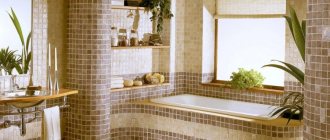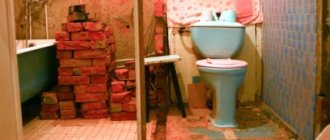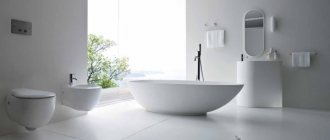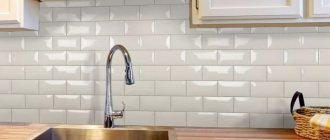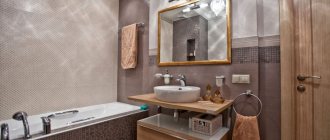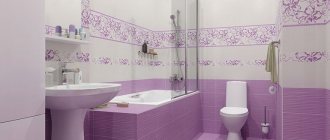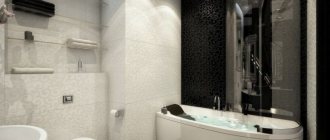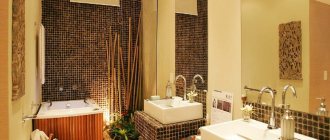Click to share
more
Many people cannot imagine a bathroom without tiles, and recent trends show that the interior can not only be furnished without it, but also done cheaper and more interesting. We'll tell you how to replace tiles to make your bathroom practical and aesthetically pleasing!
Paint instead of tiles
The bathroom is a rather special room because it is where there is both high humidity and frequent temperature fluctuations. Tiles seem to be the most practical in such spaces. However, this is not entirely true... You can replace it with modern paints that are resistant to water, abrasion and detergents. These paints have a number of advantages that make them superior to ceramic tiles in some respects.
Paint can be quickly applied to the wall with your own hands. When choosing tiles, we most often use the services of a tiler, which significantly increases the cost of repairs. The benefits of paint may also include the fact that if you change your mind about the color, you can change it quickly and inexpensively. However, you cannot use the same paint to paint the walls as you would in the living room. Most often used: latex - acrylic, ceramics. In industrial stores they are called kitchen and bathroom paints.
If the walls of your room are flat, use PVC film.
The film is waterproof, easy to apply, but very gentle. Any damage to the coating will be highly visible on a flat film sheet.
But you can find polyvinyl chloride film of any design, color and pattern - this provides an excellent opportunity for creativity.
Covering part of the bathroom walls with PVC film. Covering the entire bathroom with PVC film.
Wallpaper and wall paintings
When thinking about wallpaper, we usually think of a living room, bedroom or children's room. But not everyone knows, but there are special wallpapers suitable for the bathroom available on the market. The most popular are vinyl or fiberglass wallpaper.
They are waterproof and washable. Their manufacturers guarantee that these products can be used even in the sauna, as well as in the bath, and they will certainly fulfill their role well. The advantage of this solution is the cost itself, as well as a large selection of colors. Wallpaper is being used more and more in bathrooms, and as its popularity grows, the choice is becoming wider.
Wall murals are another interesting proposal, they will work especially in small bathrooms, where they can add depth to the interior and affect the optical appearance of the room. When choosing this solution, photo wallpapers should be covered, for example, with glass, which will protect them from moisture.
Most bathroom remodelers choose tiles for walls and floors, forgetting that there are other solutions. The market offers a wide selection of tiles: shaded, uniform in color, with or without decorations, matte and glossy. However, before making a final decision, it is also worth familiarizing yourself with other options for finishing materials for the bathroom. Thanks to the use of materials such as natural stone, glass, wood and even wallpaper and paints for decorating the bathroom, you can achieve an original and non-standard interior design.
If you want your bathroom to be unusual and stand out from others, you can use finishing materials that will certainly attract attention and give the interior a unique charm. When choosing materials for harsh environments such as kitchens and bathrooms, you don't have to worry about their durability - they are made to protect walls and be resistant to moisture, heat and cleaning agents.
Some, such as paints and wallpapers, can significantly reduce the cost of renovations as they are a much cheaper alternative to wall coverings compared to tiles. Self-adhesive laminated wallpaper is also available, which, unlike the previous ones, is made not of paper, but of foil, which makes it even more durable and resistant.
Mosaic
Along with ceramic tiles, mosaic is one of the popular types of finishing for bathrooms, showers, and swimming pools. Different materials are used in production: glass, sea pebbles, metal. Most manufacturers produce mosaics in separate elements on a plastic base, which simplifies installation.
Advantages of mosaic: stylish appearance, moisture resistance, easy installation, resistance to household chemicals, durability.
Cons: high cost, difficulty of maintenance depends on the material from which the mosaic is made.
Project author: Elena Dyakova
Project author: Elena Dyakova
Project author: Ivan Kachalov
Project author: Ivan Kachalov
The bathroom is decorated with Trend mosaics. Project author: Alexey Razorenov
The bathroom is decorated with Trend mosaics. Project author: Alexey Razorenov
Natural stone in the bathroom
Natural stone perfectly replaces traditional tiles - it is resistant to high temperatures, water and steam, as well as cleaning agents. However, it is important that it is properly polished and sanded during the preparation process, otherwise it will be unsightly and can quickly develop stains that are difficult to remove. Natural stone can be purchased in tiles of various sizes or as a uniform large slab that can be covered over a significant portion of the wall, such as in a shower stall or sink.
There are several types of natural stone to choose from. They differ in texture, structure and properties:
- Granite is the most durable type of stone, very hard and resistant to adverse factors. For this reason, it is ideal for floors and very wet areas - around the shower, bath or washbasin;
- Marble – This type of stone is available in a wide range of colors, making it easy to combine with other finishing materials used in the bathroom. Particularly recommended for large bathrooms, where their beautiful structure looks best;
- Travertine is a stone with a porous surface, with visible cracks and fissures, and is less resistant to moisture, so it is best not to use it on floors or in areas exposed to heavy moisture;
- Onyx - characterized by irregular colors, works great in mosaics in small and large bathrooms;
- Basalt is a volcanic rock that allows you to achieve customized interior effects. Its surface is slightly rough, so it is better suited for walls than floors.
The stone is extremely durable and 100% natural. Ideal for bathrooms decorated in both classic and modern styles. It is versatile, suitable for small rooms, adding elegance and class to any interior. The disadvantage is, unfortunately, the cost of stone slabs and their assembly - it is best to entrust this to an experienced specialist, since incorrect placement of the stone can spoil the expected effect and even contribute to the formation of various types of mechanical damage at a later time.
The most popular design options
Widely used materials for finishing a bathroom are:
- the most commonly used ceramic tiles and tiles;
- plastic panel options;
- special types of moisture-resistant paints;
- moisture-resistant wallpaper (glass wallpaper, vinyl, for example);
- self-adhesive films;
- use of decorative plaster, concrete;
- finishing materials based on artificial or natural stone;
- waterproof drywall options;
- special varieties of linoleum;
- glass options;
- specially treated wood (lining, among others), etc.
Yes, the choice is extremely rich, there is a lot to get confused about. In addition, each of these options has its own advantages and, of course, disadvantages.
Glass in the bathroom instead of tiles
Glass is a material that has appeared in the design of space in recent years and almost immediately won many supporters. It is ideal for kitchens and bathrooms because it is completely resistant to water and detergents. This offers great decorative possibilities thanks to a huge selection of designs and colors.
Clear, frosted (milk) glass, smooth or porous glass, varnished and coated in a variety of applications are available in the market. Glass blocks are also ideal for bathrooms, with which you can create shower walls, partitions, shelves or fill gaps in the wall, which is a very interesting device.
For the interior of the bathroom, special tempered, laminated or reinforced glass is used, which, in the event of a strong impact, breaks, forming a dense network. Thanks to this, when using glass as a decorative or finishing material, you do not need to worry about the safety of yourself and your family.
Glass can be used to cover an entire wall - large panels of glass in various colors and designs (such as screen-printed) - or smaller pieces combining glass, such as with tiles or paint. An interesting idea is to use mosaics, that is, small glass cubes, to place a bathtub or shower tray.
Wall panels for interior
The choice of such panels is extremely wide. Manufacturers offer a variety of materials and design solutions. They differ in size, texture, coating, colorability and other parameters. You can choose the material for a bathroom of any style. All panels are easy to install and very practical:
- hide communications;
- absolutely moisture-resistant, so they can be installed anywhere in the bathroom;
- are not affected by fungus;
- do not require preliminary leveling of surfaces;
- can be adjusted in size without special tools and fit into rooms of different sizes;
- environmentally friendly;
- are cheaper than tiles.
They also have disadvantages:
- Many options have low resistance to mechanical stress. From impact they crack, chip, and become deformed.
- The panels are mounted on the frame and conceal about 10 cm of usable area during repairs. An alternative option for a small room is to glue the material directly to the wall.
Advice. If your bathroom interior concept without tiles involves the use of several types of panels, purchase elements with the same locks.
Types of panels
The choice of panels depends on imagination and financial capabilities. The following materials are available for sale:
- Wood. The status, solid appearance of walls in this design will decorate any bathroom. True, this pleasure is expensive. Manufacturers offer many varieties of wood: from light to dark, from simple to elite. The material is impregnated with special protective compounds and varnished.
- MDF. Thanks to the manufacturing principle, these panels are very durable. You can attach various hanging interior elements to them. The material is covered with a special protective layer on top. If it is damaged, the entire cladding part will have to be replaced.
- Glass. Many modern styles welcome this type of bathroom design. The glass surface can be transparent, matte, or depict ornaments or entire landscapes. The facing is mounted like a regular mirror. For one bathroom, 1-3 large glasses are enough. They will occupy 1-2 walls.
- Plaster vinyl. These are plasterboard panels with a vinyl layer glued on. The latter simultaneously performs moisture-protective and decorative functions. The material is mounted on aluminum profiles.
- 3D. The ornament on such panels resembles the relief of real stucco. At the same time, the material itself is light and meets the main requirements of the bathroom. Designers combine three-dimensional panels with spot lighting and create atmospheric compositions in the room.
- Hardboard and PVC. These types of advanced plastics meet all bathroom challenges. They are also available in a huge range of sizes, shapes and imitate various natural materials. If you choose quality products, the finish will not look cheap.
Important! The disadvantage of plastic is that it is easily flammable. The wiring will have to be additionally insulated.
A bathroom without tiles is possible. Modern design involves a harmonious combination of several materials. Create a unique atmosphere in your bathroom.
Wood for the bathroom instead of tiles
Wood finishes undoubtedly add charm to a bathroom, warm it up and are a natural complement to the dominant ceramics, metal and glass in the interior. Bathroom accessories can be either wooden or larger ones such as a bathtub, shower tray or even flooring. The main thing is to choose the right type of wood for the bathroom, resistant to moisture and temperature changes.
Exotic wood species that work best here include teak, jatobe, cedar, dussi, marbau, iroko, lapacho, badi and wenge - they are characterized by the highest moisture resistance, so they can be placed next to the sink, bathtub or shower. Kempas, guatambu, zebrawood and African walnut (bibola) are slightly less resistant to moisture. You can also choose local tree species such as oak, elm, ash, beech, larch, pine, spruce, cherry and pear.
A very important issue for wood is its adequate protection from moisture, as well as regular impregnation - by varnishing, oiling, staining, waxing or painting - especially for less resistant species.
An interesting arrangement idea is to combine tiles with painted walls. Thanks to this, the bathroom acquires lightness, the decor is not monotonous and not homogeneous. You could, for example, tile up to a certain wall height and cover the top with wallpaper or paint, or tile an entire wall, such as one with a shower or bath, and paint another, such as the one with the washing machine. This solution will also bring savings because you don't have to buy tiles, adhesive and grout to cover the entire bathroom.
As you can see, there are many options for organizing your bathroom space, so you don't have to limit yourself to just tiles. Sometimes it's worth experimenting to find out what other materials can make your interior unique and delightful for years to come.
more
What's good about painting?
Here, durable and non-toxic acrylic paints with special compositions that completely protect walls from moisture and mold (with the addition of silver ions) are best suited.
You can also use latex and silicone paint options. They remain the simplest and cheapest option for decorating a bathroom with your own hands: they are easy to wash and clean, they can be applied to any type of wall, and quickly repainted if necessary.
Negative characteristics include the impossibility of masking unnecessary elements, the need for high-quality ventilation for the durability of the coating, and the inevitability of periodic updates. In addition, preliminary high-quality preparation is needed, priming the wall in water-repellent versions.
Still, it is not recommended to use paint near water, but to combine it with other materials in these places.
Features of decorative plaster
Its moisture-resistant options allow you to create unique design solutions, are easy to apply, can normalize the microclimate, but are not cheap, including finishing costs, and are difficult to dismantle.
Before making a specific choice, you should familiarize yourself with the proposed photos of bathroom decoration in order to calculate all the possible and most optimal options comparable to your budget, and boldly go towards your dream.
Using lining
Finishing a bathroom with wooden lining can be either using a special plastic lining, or its moisture-resistant versions, treated in a special way (varnish, wax, painting, or other lubricants) for high-quality protection from humidity and water. Still, the main disadvantage of lining is its fragility when compared with other materials.
Due to its vertical positioning, it visually enlarges the space and gives the room a feeling of warmth, comfort, and naturalness. It involves the use of suitable accessories that emphasize this particular style. More often used in country private houses.
